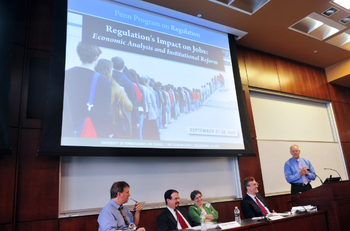
Why requiring a regulatory impact analysis on jobs is ill-advised.
“Job killing regulations” is an epithet commonly heard this year, with unemployment at persistently high levels and a presidential election cycle just completed. Many politicians and media commentators have come to accept this phrase as axiomatic, and for them, it is a convenient shorthand for what they believe is a major cause of current high unemployment rates and the economic downturn.
To provoke critical commentary on this widely accepted assumption, the Penn Program on Regulation (PPR) recently convened a conference to examine two simple questions: “Do regulations kill jobs?” and “How do we know?” At the conference, scholars, government officials, and private-sector representatives met to exchange views on what research currently has to offer in response to these questions. The consensus answer to the questions seemed to be, “Maybe regulation does affect jobs, but the impacts do not appear to be significant, and they may be either negative or positive.”
In light of this conclusion, a third question appeared: “Should the federal government require a regulatory impact assessment on jobs?” My answer is, “No.” The complex history of regulatory impact analysis reveals the reasons behind this answer.
Regulatory impact assessment started off simply. Executive Order 12291, issued in February, 1981, by President Reagan, required a Regulatory Impact Analysis of costs and benefits. Twelve years later, President Clinton’s administration, led by Office of Information and Regulatory Affairs (OIRA) Administrator Sally Katzen, remodeled the regulatory review executive order, keeping its essential structure but adding numerous regulatory goals. Executive Order 12866 made regulatory impact analysis more complex. The order begins with a preamble, followed by a statement of regulatory philosophy, followed by a set of twelve regulatory principles. Deconstructed into individual provisions, these introductory sections delineate at least two-dozen goals of good regulation that are, for all practical purposes, also a set of impact analysis directives.
These goals of good regulation include protecting human health, safety, and the environment, as well as the analytically more troublesome reduction of discrimination or bias. Also included are goals related to the promotion of the efficient functioning of the economy and private markets, including productivity, competitiveness, and, notably, employment.
President Obama’s Executive Order 13563 supplements E.O. 12866 by reinforcing certain objectives and adding others, including further emphasis on promoting economic growth, innovation, competitiveness, distributive impacts, equity, human dignity, fairness, and, again, job creation.
As commentators have pointed out, both E.O. 12866 and E.O. 13563 appear to have a requirement for the very jobs impact analysis that we all seem to agree we may not know how to do! How can this be, and why is the requirement in an executive order?
The answer, I argue, is that regulatory impact analyses have never been limited to analysis that either can be or is expected to be done. Congress has previously mandated that a litany of different impact areas receive their own impact analyses, including:
- The Paperwork Reduction Act’s red-tape burden reduction and practical utility impact analysis;
- The Unfunded Mandates Reform Act’s evaluation of state, local, and tribal government impacts;
- The Regulatory Flexibility Act’s small business impacts;
- The Privacy Act’s Privacy Impact Statements;
- A short-lived appropriations rider in the 1990s calling for a family impact statement;
- The Information Quality Act’s quality of impact information impact statement; and
- The Plain Writing Act’s can-the-reader-understand-this-impact-statement impact statement.
Likewise, the President, by executive order, has demanded specific attention to various other impacts, including: E.O. 13132 on federalism; E.O. 12630 on takings of private property; E.O. 12898 on environmental justice; E.O. 12875 on enhancing the intergovernmental partnership; E.O. 12988 on civil justice reform; E.O. 13045 on protection of children’s health; E.O. 13211 on energy supply, distribution, and use; and E.O. 13609 on promoting international regulatory cooperation.
Direction on the focus of regulatory impact analysis can be found elsewhere still. With Vice President Dan Quayle’s Council on Competitiveness in existence between 1989 and 1992, OIRA and the agencies focused on competitiveness at that time. When manufacturing was in decline in the early years of President George W. Bush’s administration, regulators worried about the impact of regulations on manufacturing. More recently, a President Obama memorandum requires special consideration be given to the impacts of regulations on small business and job creation. Further, memoranda from former OIRA Administrator Cass Sunstein established principles for, among other things, retrospective analysis of existing rules; the cumulative effects of regulation; decision-making related to nanotechnology and nano-materials; export and trade promotion; and emerging technologies. A multi-agency report even provides information on the social costs of carbon to be used in regulatory impact analyses.
Are there any impacts left to require?
The motivation for these impact analysis directives is seldom only to, in the words of the Preamble to the Constitution, “Promote the General Welfare” of the people of the United States. In my experience, they were often created as solutions to immediate and generally short-term political problems. Many are efforts of regulatory opponents who believe that such impact statements will reveal the inherent and intuitively obvious stupidity of regulations and will serve to eliminate rules or at least slow them down (for example, the executive order on takings or the Unfunded Mandates Reform Act). Such efforts are countered by regulatory proponents who believe the opposite – that analysis will demonstrate the need for both more and stricter rules (for instance, executive orders on environmental justice or children’s health). Some of these requirements are clearly more important than others. The Paperwork Reduction Act and E.O. 12866 have been in effect now for twenty years, across both Democratic and Republican administrations. In contrast, the Unfunded Mandates Reform Act of 1995 has proven to be far less effective than its creators hoped, while the mandated family impact statement quickly faded into the past. Looking back from ten or twenty years hence, future regulatory impact analysts are unlikely to regard the current administration’s directives on export and trade promotion or nanotechnology as being particularly important.
The political winds have blown us the flotsam and jetsam of impact analyses over the past 30 years. Despite the often negligible effect of most of them, remarkable advancement in regulatory impact analysis has been made over the past three decades, though seldom because it was mandated by a political body. It is important to continue working to expand the boundaries of analytic expertise, particularly concerning those indirect and macro-effects that, like risk assessment fifteen years ago, need care and nurturing. This expansion is done best when it is done carefully and by professionals, as some observers have suggested, to reduce the opportunity for political decision makers, particularly during election campaigns, to misuse such analysis.
For such analyses to be useful, they need to have an integrity that comes first from academic and other experts—people like the participants at the recent PPR conference. It makes a difference for political policy makers in the White House to know that an analytic method and its results are built on a consensus view of the profession. Such methods are best developed through empirical study and testing in trials at some agencies so that experience can help resolve the inevitable problems. Of course, it can take much effort and a long time to develop methods on which practitioners agree. But this evolution is best left free from congressional or executive interference, although interest by these bodies does help stimulate interest in the scholarly community. We already have an administration directive for job impact analysis without a real method to conduct such work. Although Congress frequently believes that if it mandates something then it must occur, the results of the PPR conference make perfectly clear that such a directive requiring a regulatory impact analysis on jobs cannot be reasonably implemented.
In my opinion, analytic requirements are like agencies. Once created, they seldom go away. Their lingering existence does not mean they still serve a useful purpose. Old impact statement requirements meet a lonely and doleful demise—their once proud aspirations dulled and forgotten; their exaggerated promise relegated to the impact analysis dust bin; their sad fall from glory giving rise to a mild and vaguely embarrassing schadenfreude in us all. They stumble into their dotage in the Federal Register on the concluding pages of rules as humiliated, featureless, grey boilerplate.
We would not want analysis of the regulatory impact on jobs to meet a similar, depressing fate.




